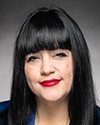Thank you to the indigenous and northern affairs committee for the opportunity to speak to you today on improving graduation rates and successful outcomes for indigenous students.
My name is Shelagh Rowles. I'm the provost and vice-president academic at Yukon University. I began working at the university in 1991 when it was Yukon College, spending my first six years in the fly-in community of Old Crow.
Typically, I would be joining you from my office in Whitehorse, located on the traditional territories of the Kwanlin Dun First Nation and the Ta'an Kwach'an Council, but today I’m joining you from Moab, Utah, on the traditional and ancestral lands of the bands of the Ute and the clans of the Ancestral Pueblo people.
I’ll start by telling you more about Yukon University. We're a progressive post-secondary institution and Canada’s first and currently only university north of 60. Yukon U is early in our journey to becoming a university, but we've been providing post-secondary education in the north since 1963. Our 13 campuses are situated on the traditional territories of the 14 Yukon first nations in 12 communities. Our vision is to become a thriving learning and research community leading Canada’s north.
The university's first strategic plan sets out one of our priorities for the next five years as taking our place in advancing reconciliation. That means we'll strengthen our collaboration with Yukon first nations to meet their goals in education.
Little Salmon Carmacks elder and chief Roddy Blackjack, often spoke of the importance of keeping indigenous and western world views side by side. Every graduate and employee of Yukon U must complete a Yukon first nations competency to ensure understanding and appreciation for the unique context we operate in throughout the Yukon.
It’s also important for me to mention to you that Yukon University operates in a territory that, like many other places in Canada, has been rocked by several concurrent crises: the pandemic, substance abuse, affordable housing and the cost of living. All that is to say that the past few years have been incredibly difficult for our communities. Barriers to obtaining high school education and later to post-secondary studies have grown significantly. However, Yukon communities and Yukon U have adapted and were resilient.
I’d like to share with you several success stories from the past few years, flowing from federal investment in key areas of housing and infrastructure, economic diversification, environmental protection and remediation. You’ll notice that there's a common theme of bringing education to people in their communities, instead of insisting that people travel hundreds of kilometres to access programming.
My first example is Yukon University’s housing maintainer program. The program has been impactful in Yukon communities. During the past two years, the university has worked with three first nation governments to deliver the program to 29 students. Students developed knowledge in the skilled trades and acquired an understanding of modern building science. They were able to use the course hours towards an apprenticeship if they decided to pursue those paths—plus, they increased housing capacity in their home communities.
The Yukon first nations arts certificate program provides an incredible opportunity for emerging entrepreneurs and craftspeople. It was delivered in 13 communities to 84 students between 2019 and 2022, in partnership with Yukon first nation governments. It was funded through the northern adult basic education initiative through CanNor. The classes were delivered on timelines suitable for each community and drew from the expertise of local artists. The program fostered the development of local businesses and was the platform for students to support each other during the trying days of the pandemic.
Land use planning, environmental remediation and environmental monitoring are key priorities stemming from the Yukon land claims and self-government agreements. There are 57 students who have completed or are in the environmental monitoring certificate program, which runs in a compressed model offered several times per year for people employed as monitors in their community or who are training to become a monitor. All graduates are employed.
While some of these numbers may seem small, providing the knowledge and skills for just one individual can make an incredible impact on a community of three hundred or four hundred people. It can mean that water quality is monitored and that repairs to the community gathering space or housing can be done without waiting weeks for someone from afar to come.
There's a tremendous opportunity for the federal government to have a greater and more meaningful impact on small northern communities in the areas we've outlined. What's required is stable, longer-term funding models that enable us to collaborate with Yukon first nations to develop, build, deliver and assess the programs we offer for the greatest success, and to scale up and expand when we achieve it.
I appreciate the opportunity to speak to you all today.



